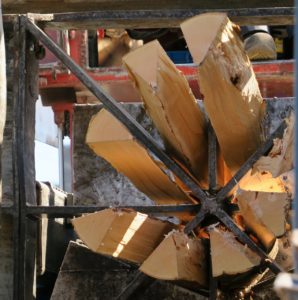Many individuals despise the task of log splitting. It’s difficult, time-consuming, and inconvenient – an electric wood splitter could be the solution to all of your issues! With so many models on the market, deciding which one is right for you might be difficult. This blog post will go over five essential variables to consider when determining which wood splitter is appropriate for you and your needs at home.
What Types of Logs Do You Plan to Split?
 The first question to ask yourself is what types of logs you plan on splitting. The size and type of wood you split will determine the power and capacity you need from your log splitter. A manual or electric log splitter will do the trick for smaller, more manageable logs. If you are looking to split large logs, you will need a gas-powered model.
The first question to ask yourself is what types of logs you plan on splitting. The size and type of wood you split will determine the power and capacity you need from your log splitter. A manual or electric log splitter will do the trick for smaller, more manageable logs. If you are looking to split large logs, you will need a gas-powered model.
The more often you intend to use your log splitter, the more powerful a model you will need. If it is for infrequent or emergency use only, then an electric or manual option is worth working just fine! If you have the space to store logs horizontally, then a model that splits the wood in two and drops it on the ground will work well for you. A log splitter that stacks the split logs into a pile will be ideal if you do not have this luxury.
How Often Will You Be Splitting Logs?
The next question you should ask yourself is how often you plan to split logs. If it is for infrequent or emergency use only, an electric or manual option will work just fine! You may not want to splurge on a heavy-duty gas-powered model if this isn’t going to be a common task around the house. If you are splitting logs more frequently, a larger and heavier model will likely suit your needs best. If it is for infrequent or emergency use only, an electric or manual option will work just fine! You may not want to splurge on a heavy-duty gas-powered model if this isn’t going to be a common task around the house.
What Is Your Budget Range?
 Another essential factor to consider is your budget. You can purchase a log splitter for as little as $100, which will work if you only split an occasional piece of wood with it. If you only split a few logs at a time, then an electric or manual option works well! You can find these models for as little as $100 if you use them infrequently.
Another essential factor to consider is your budget. You can purchase a log splitter for as little as $100, which will work if you only split an occasional piece of wood with it. If you only split a few logs at a time, then an electric or manual option works well! You can find these models for as little as $100 if you use them infrequently.
If you plan on using the tool more than once per month, then investing in a quality gas-powered model would be ideal. These models start at around $400 and go up from there. Keep these five factors in mind before making your purchase! It can make a difference when finding a suitable log splitter for home use. If you are looking for a reliable gas-powered log splitter, then contact us today to learn more about the options available to you!
